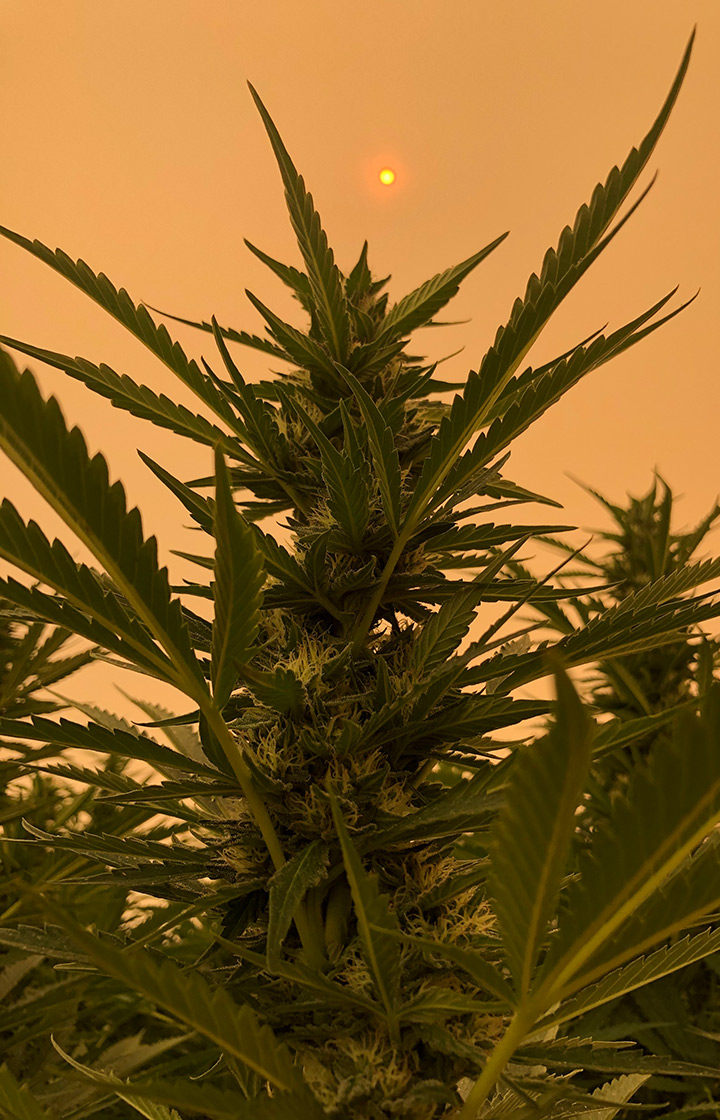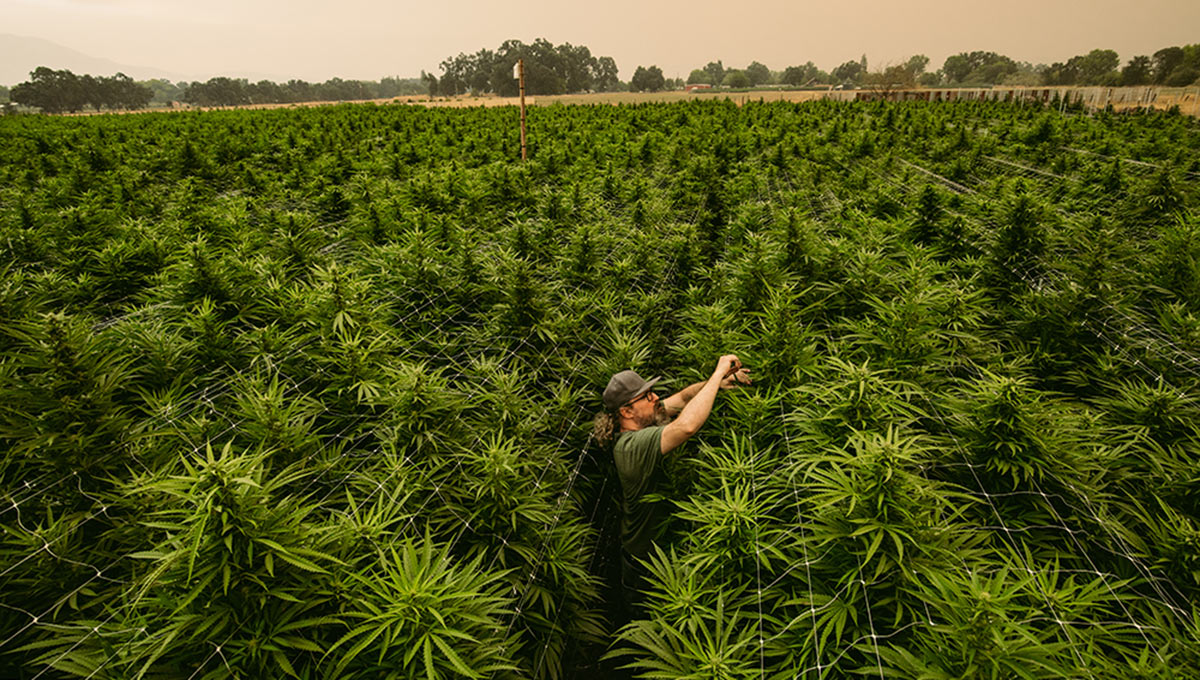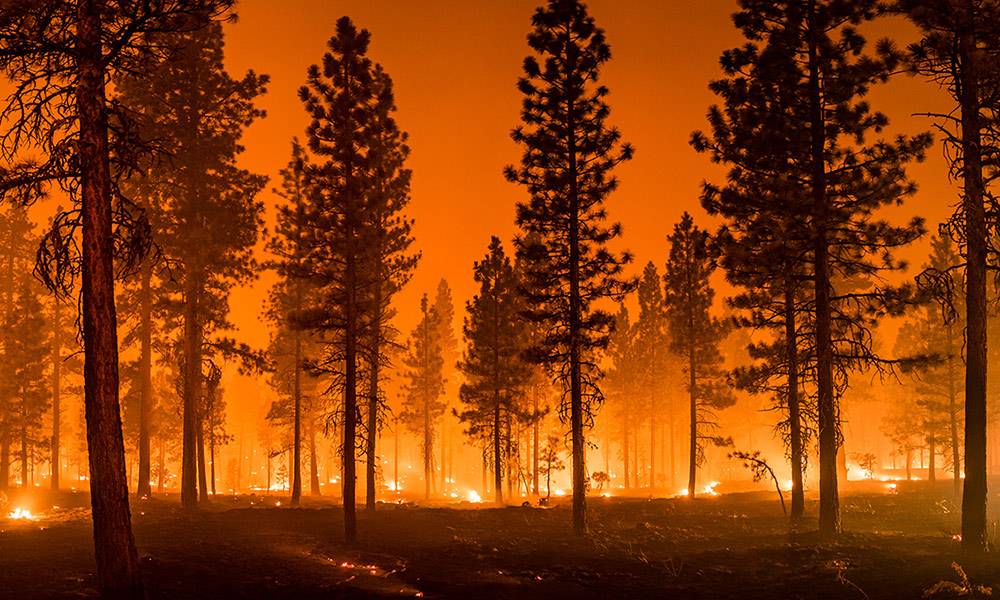By Dante Jordan
Wildfires are destroying California, and with it, the entire livelihoods of sungrown cannabis farmers who have called The Emerald Triangle home for decades. Just two years after the historic Mendocino Complex Fire that burned 459,000 acres, the unprecedented August Complex gigafire that has raged since August 16, and is still just 77% contained as of this writing, has now scorched over 1 million acres. It’s forced emergency evacuations that have caused some growers in Humboldt, Trinity, and Mendocino counties to not only leave behind the 2020 season’s harvest, but also their farms, homes, and everything else they own. Imagine watching your life’s work burn to the ground year after year: that’s what California sungrown farmers are experiencing.
It’s the reason legendary cannabis breeder Subcool (RIP) had to move his business to Arizona, and Jennifer Michaels of NorCal Seeds and Genetics had to leave Sonoma County. It’s the reason that Tina Gordon of Moon Made Farms and Jeff Nordahl of Jade Nectar fear they may have to do the same.
What Are the California Wildfires?
Climate change is real. The science is there, and the fires are right in front of us. Wildfires have always happened naturally, but over the past couple of years, California has faced record-breaking infernos that show we’re dealing with a completely different environmental beast now. In addition to California, the changes in climate are also affecting the states of Washington and Oregon as wildfire season becomes an issue for the entire west coast.
The two most recent 2020 fires, for the sake of this conversation, are the Mendocino Complex and August Complex fires.
Mendocino Complex Fire
Formerly known as the largest wildfire in California state history, the Mendocino Complex Fire was a wildfire that burned through Lake, Mendocino, Glenn, and Colusa counties in Northern California for over three months. It consisted of two flames: The Ranch Fire and The River Fire, that blazed through 459,000 acres of land. It would be impossible to tell you exactly how many growers and companies were affected by the fire, considering you’d have to include both legal and under-the-radar farms, but considering the blaze destroyed 280 buildings, it’s safe to assume that weed was not left unharmed.
August Complex Fire
The newly-crowned largest wildfire in California state history, and the nation’s first “gigafire,” is the August Complex fire. According to Capradio.org, as of 9 a.m. on Oct. 15, these fires had burned 1,029,605 acres and were 77% contained. Additionally, one firefighter has died, and 11,310 structures are threatened and 23 structures have been destroyed. This is the fire responsible for all those viral pictures of orange California skies, and the videos of people driving through California without a single bit of visibility.
How Do the California Wildfires Affect Cannabis Growers?
Farmers are losing way more than just some plants. They’re losing millions of uninsurable dollars; entire seed banks; mother plants, proprietary genetics, houses, clothes, memories, and anything else they hold dear. With evacuations being in a state of emergency, rarely are people able to pack up any of their possessions, and they aren’t allowed to return for such until the fires are contained.
Michaels, who suffered in the 2017 Sonoma Complex wildfires, tells me, “I did lose some of my genetics. However, our house didn't burn down for a week, so I was lucky enough to sneak in during the evacuation time and get a few things. I was able to save my [Merlot Kush, Cabernet Kush, and Pink Champagne strains] that we worked so hard on over the years. But I did lose everything in the house, all of my cool clothes, and some of the finer things that me and my husband had collected over the years from traveling.
Past leaving behind possessions, the evacuations also force growers to face the reality that they may have to leave their communities.
Gordon, who had to evacuate southern Humboldt county, tells me, “The evacuation really forced me to confront a lot of issues that I hadn't faced before. One of those is leaving this place and potentially losing everything, but it’s more than that. It’s what this place means. It's the heritage, it’s the history; this is at the heart of the Emerald Triangle.”

How Do the California Wildfires Affect Cannabis Crops?
While on a video call, Nordahl showed me some Columbian Gold that was grown in Boulder Creek (Santa Cruz). On how it's affected by smoke, he says, “It smells beautiful, but it has a slight hint of smokiness. I’m hoping that it will cure out. The smokiness went down as I trimmed off the sugar leaf because I think a lot of that smoke was sitting on the leaves, but we’re kind of venturing into the unknown. We have to lab test it to make sure it doesn’t test high for roofing shingles, burnt carpet, and whatever else is in the air.”
In addition to the soot and ash, all of the smoke blocks sunlight from reaching the plants, and the high temperatures dehydrate them. With evacuations, there is often no one left behind to save the plants during this time. This often forces growers who have been evacuated to find creative ways to sneak back in. Like Michaels in 2017, Nordahl, who was evacuated due to the CZU Complex Fire, snuck his way in to save his babies. With road closures, Nordahl tells me, “Sometimes it was a 12-mile round trip hike just to get in and out. We're talking starting at 5am in the pitch black. We got in and luckily we had enough water in our holding tanks, cause we were on a well. But each time out there, the plants probably wouldn’t have lasted another 24 hours. Not only was it fire and smoke, but we also had a heatwave going, so the plants were just taking a beating.”
What Can Farmers Do to Save or Protect Their Crops?
Smoke-tainted cannabis isn’t always a lost cause. Sometimes farmers save their crops by using leaf blowers and shaking to remove soot, ash, and other airborne contaminants from the wildfires. Depending on the stage of plants, this may help. Unfortunately for California farmers, the wildfires often occur during the cannabis’ flowering and harvesting cycles. This is the worst time possible as the plants are finishing, so whatever has touched them, is more likely to stick to those fully-developed trichomes.
Some growers save their crops, and investment, through remediation and extraction. The extraction process usually removes any microbial contaminants from smokey flowers and washes them into clean, safe, consumable hash oil. Outside of extraction, there aren’t too many other remediation options.

Is There Cannabis Crop Insurance?
No. Cannabis is still federally illegal, and just like banks won’t support cannabis money, insurance companies won’t insure it. The ones that do often get burned, no pun intended, due to having so many claims to pay out during wildfire season.
What Is the Future of California Cannabis vs. Fire Season?
The sad truth is there’s not much optimism to spread. It only took 2 years for California’s biggest fire ever to become the second biggest fire ever. With the rapidly growing effects of climate change, these wildfires are only going to get bigger, longer, and more ferocious. At this point, all Northern California cannabis farmers can really do is roll with the punches, and make adjustments where possible.
Nordahl and Jade Nectar, who make tinctures, may have to change their entire production process and start growing more semi-autoflowering plants to race the wildfire clock. “For our production, we just have to have a certain amount of Sativas, a certain amount of Indicas, and a certain amount of CBD to make all of our formulas. If we’re able to finish out all our critical production before the first week of August, then we can [do] all our other fun projects that aren't crucial to our existence, and let that just be a roll of the dice. If they make it, if we don’t have catastrophic fires, then yay for us, a bonus year. But at least it wouldn’t be devastating to our company’s operation and production, if we have to deal with wildfires again.”
Gordon suggests, “It is time to learn how to do controlled burns. Controlled burns and regenerative farming are all I keep thinking about. Say you burn a small area annually. What you’re doing is opening space, but also bringing fertility to the land. The fertility is going to help bring biodiversity to the land, and that biodiversity is going to help with climate change. There’s a whole systemic effect that can have as far as small fires versus really massive out of control fires.”

